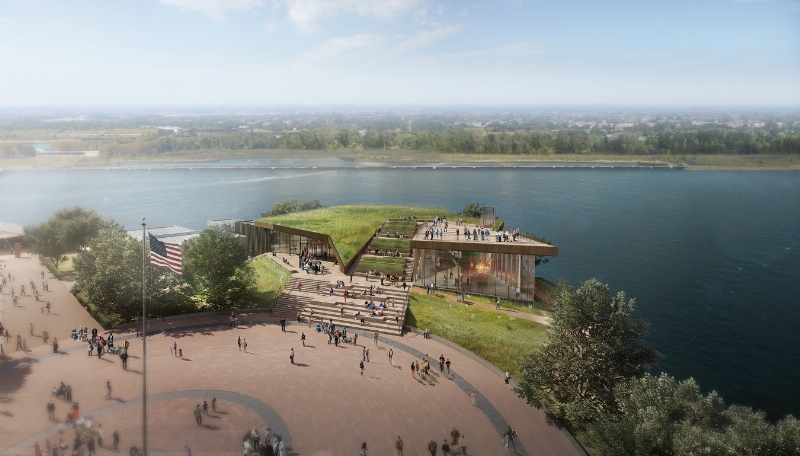Liberty Island, the home of the Statue of Liberty in New York Harbor, is about to receive a new 26,000-sf Statue of Liberty Museum. The museum will provide guests to the tiny island an alternative experience if they are not one of the lucky few to actually get inside the statue.
The $70 million museum is being designed by FXFOWLE and will be built by Phelps Construction Group. Phelps has worked closely with FXFOWLE in order to determine the most efficient way to construct the sustainable building.
The first floor of the new museum will be built above the 500-year flood level and will have the ability to withstand hurricane force winds. Part of the roof will be planted with vegetation native to the area while the rest will be used as a viewing platform flanked on one side by Lady Liberty and on the other by the Manhattan skyline.
The interior of the museum will feature exhibits and interactive displays providing information about the Statue of Liberty’s history, influence, and legacy. ESI Design will create the exhibits, which will include a theater, an engagement gallery, and an inspiration gallery. One of the largest pieces on display in the museum will be the Statue of Liberty’s original torch, which was replaced during a renovation of the statue in the 1980s. The torch will be displayed in a glass-walled space allowing visitors to view the old torch and its replacement at the same time, according to The New York Times.
Funding for the museum is being covered by the Statue of Liberty-Ellis Island Foundation, which has already raised about $40 million.
The expected completion date for the new museum is in 2019.
Related Stories
| Aug 11, 2010
Museum celebrates African-American heritage
The Harvey B. Gantt Center for African-American Arts + Culture recently completed construction on the Wells Fargo Cultural Campus in Charlotte, N.C. Designed by the Freelon Group, Durham, N.C., with Batson-Cook's Atlanta office as project manager, the $18.8 million project achieved nearly 100% minority participation.
| Aug 11, 2010
Design for Miami Art Museum triples gallery space
Herzog & de Meuron has completed design development for the Miami Art Museum’s new complex, which will anchor the city’s 29-acre Museum Park, overlooking Biscayne Bay. At 120,000 sf with 32,000 sf of gallery space, the three-story museum will be three times larger than the current facility.
| Aug 11, 2010
Thom Mayne unveils ‘floating cube’ design for the Perot Museum of Nature and Science
Calling it a “living educational tool featuring architecture inspired by nature and science,” Pritzker Prize Laureate Thom Mayne unveiled the schematic designs and building model for the Perot Museum of Nature & Science at Victory Park in Dallas. The $185 million, 180,000-sf structure is 170 feet tall—equivalent to approximately 14 stories—and is conceived as a large...
| Aug 11, 2010
Piano's 'Flying Carpet'
Italian architect Renzo Piano refers to his $294 million, 264,000-sf Modern Wing of the Art Institute of Chicago as a “temple of light.” That's all well and good, but how did Piano and the engineers from London-based Arup create an almost entirely naturally lit interior while still protecting the priceless works of art in the Institute's third-floor galleries from dangerous ultravio...
| Aug 11, 2010
The Art of Reconstruction
The Old Patent Office Building in Washington, D.C., completed in 1867, houses two Smithsonian Institution museums—the National Portrait Gallery and the American Art Museum. Collections include portraits of all U.S. presidents, along with paintings, sculptures, prints, and drawings of numerous historic figures from American history, and the works of more than 7,000 American artists.
| Aug 11, 2010
Silver Award: Please Touch Museum at Memorial Hall Philadelphia, Pa.
Built in 1875 to serve as the art gallery for the Centennial International Exhibition in Fairmount Park, Memorial Hall stands as one of the great civic structures in Philadelphia. The neoclassical building, designed by Fairmount Park Commission engineer Hermann J. Schwarzmann, was one of the first buildings in America to be designed according to the principles of the Beaux Arts movement.







